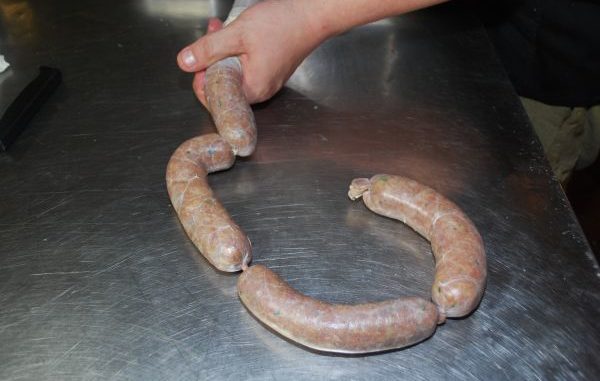
Boudin (pronounced BOO-dan) has become a cult food in South Louisiana, and is rapidly penetrating the rest of the state.
Since very few outlets sell boudin rouge (red boudin or blood sausage) anymore, the term boudin nowadays almost always refers to boudin blanc, a white-colored sausage made up of varying amounts of pork (usually pulled, not ground), pork liver and heart, rice, seasonings and spices.
Once sold only at mom-and-pop groceries, service stations, small meat shops and lunch counters, boudin has penetrated wedding catering and fine-dining restaurant menus.
Every boudin-lover has his or her own opinion about the proper amount of liver, rice or pepper that should be in the sausage.
With the mystique that has developed about the dish, few hunters know how easy it is to make it at home, as long as they have a sausage stuffer. Mark Falgoust urges budding boudin makers to keep it simple.
“Cajuns don’t have a pantry full of nutmeg and allspice,” he said. “All Cajuns need is a black iron pot, cooking grease and onions — and rice.”
He offered these tips:
• Don’t use tenderloins and hams for boudin. Save those for other preparations, and use lesser cuts here.
• Don’t overcook the meat. Break it into small pieces as soon as it can be pulled from the bone.
• A meat grinder can be used to break the heart and liver into smaller pieces.
• Casings can easily be obtained from most major sporting goods stores that have a cooking section.
The key to good boudin, he said, is to use the liquid the meat was cooked in to make the rice. His favorite rice is the Louisiana aromatic rice, Jazzman.
Make sure that the rice is fully cooked before it is used, and mix it very well with the meat so the rice is partially broken down. You don’t want a grainy end product.
Wild Hog Boudin
10 lb. bone-in pork shoulder, back legs and pelvis
2 lb. pork heart and liver
2 qt. onions, cut into large pieces
2 qt. celery, cut into large pieces
2 qt. bell peppers, cut into large pieces
1 cup diced garlic
15-20 bay leaves
1/2 cup sweet paprika
1 tbsp. cayenne pepper
3 tbsp. kosher salt
1 tbsp. black pepper
1/2 tsp. Insta Cure No. 1
Chicken broth
2 qt. uncooked rice
4 bunches green onion, chopped
1 bunch parsley, chopped
2 tbsp. Crystal hot sauce
2 packages hog sausage casings
Place the pork meat in a large pot.
Butterfly the heart and remove the top arteries and fat. Separate the lobes of the liver and remove the connective tissue. Cube the heart and liver into 1-inch pieces and add to the pot.
Add onions, celery and bell peppers, garlic, bay leaves, paprika, cayenne pepper, kosher salt, black pepper and Insta Cure.
Add enough chicken broth to cover the meat completely, and bring to a boil. Reduce to a simmer and cook until the pork is tender. Remove the meat and veggies with a slotted spoon.
Strain the liquid and reserve one gallon and any remaining solids.
Bring the liquid to a boil and add rice, reduce heat and cook until done.
Break the meat by hand into a large bowl, and remove any bone particles and connective tissues. Press the heart and liver through a coarse strainer, add to meat and mix well. Add green onions, parsley and cooked rice and stir to blend well.
Taste the mixture for salt and pepper and adjust as necessary.
Add hot sauce and stir to distribute the hot sauce through the mixture and set aside.
Stretch one end of each casing one at a time over a water faucet, and run water through it to rinse away the preserving salt. Squeeze to remove excess water. Tie a knot in one end of a casing and stretch the other end over the outlet of a sausage stuffer.
Prick the end of the casing near the knot to let the air out. Fill the casing with the meat mixture.
Don’t pack the casing too tight or it will explode when cooked.
At 6 or 7-inch intervals, twist the casing to form links. The next link should be twisted in the opposite direction.
At the end of the casing, tie another knot.
Repeat until all of the meat mixture has been used.
Boudin is a cooked, ready-to-eat product, and can be warmed by simmering in water or steaming. It is also delicious grilled or smoked. Boudin freezes extremely well.


